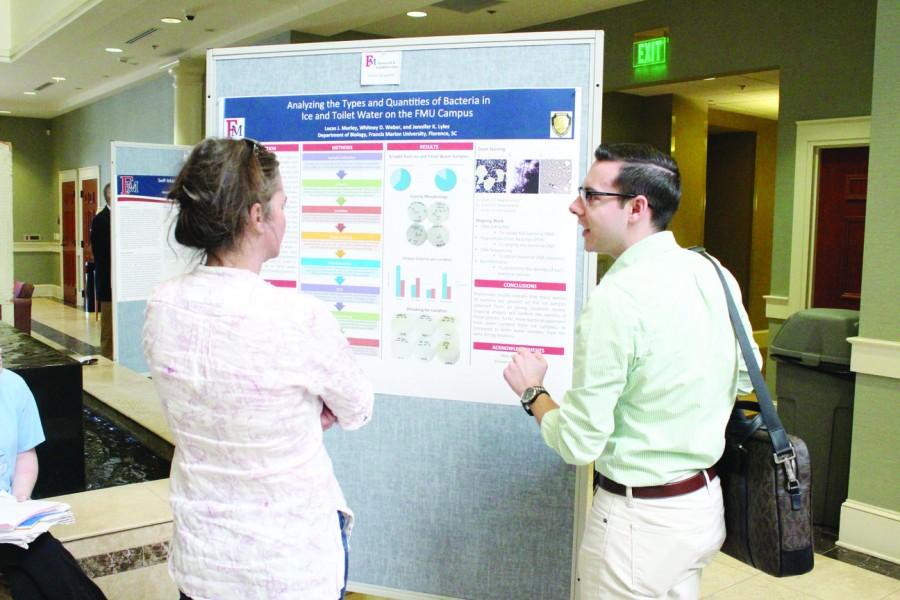Students present posters, speeches on research projects
Photo by: Dani Isgett
Senior Lucas Murley presents his research on the types of bacteria found on ice and toilets at FMU. Murley and Whitney Weber are conducting this research for their honor’s thesis.
FMU held the annual Research and Exhibition Day (RED) in Lee Nursing Building (LNB) to present research that students have conducted throughout the year.
According to the university website, the purpose of RED is to celebrate FMU students’ projects that have been worked on during the academic year, although projects do not have to be completed to be included.
Students from all areas of academic study were invited to join in RED and the range of participating students’ majors included biology, psychology, mathematics, mass communication, sociology, chemistry, visual arts, history and art education.
“At FM Research & Exhibition Day graduate and undergraduate students get the opportunity to share the work that they have completed with the FMU faculty, staff and students,” the website said.
The event included nine 30-minute presentation times, with 38 individual student researchers as well as two posters presented by the chemistry 102 honors lab. These poster presentations were ongoing during the entirety of RED, with one break from 12 p.m. to 1 p.m.
Kendrick Hardison, a junior mathematics and economics double major, participated in RED for the first time this year with both an oral presentation and a poster.
“I decide to present at RED to show my ideas to others not in the math community,” Hardison said. “This also gave me a chance to get feedback from individuals who are not deep into mathematics.”
Hardison’s poster presentation, “Closing the Gap on Multifold Triple Systems,” expands on previous research by mathematicians, which partially solved the problem Hardison is now attempting to complete.
Hardison’s oral presentation, “A New Method to Find Overall Best Lifter at Powerlifting Meet” focused on powerlifting.
He has found that there are six methods that are used to determine the best overall lifter in a given competition. His research uses the method most often implemented in the U.S., which he said is the Wilks Formula.
“This formula shows bias towards absolute strength versus relative strength,” Hardison said. “I have derived a much more simple formula that uses the age, bodyweight and total weight lifted to give an unbiased decision of overall winner.”
Hardison said that it was exciting to share his research with others. He added that he received solely positive feedback.
“The most exciting part was giving the talk in front of professors and friends, even though I loved standing by my poster and answering questions,” Hardison said.
Hardison plans to expand on both of the research topics he presented at RED this year. He also plans to participate in RED again next year.
Kate Strickland, sophomore art education major, also presented at RED for this first time this year.
Strickland’s research began last semester during an art education trip to New York City (NYC). Strickland said it was exciting to share her research and creative process with others.
“Most people don’t know about what kind of research is done in the art field,” Strickland said. “In other disciplines such as science or psychology you’re looking for answers or numbers, but in the creative process you’re looking for inspiration.”
Strickland said that during the art education trip to NYC she studied Pablo Picasso and the creative process. These were then used as inspiration to create her own sculpture, she said.
Strickland said that she got largely positive feedback and will participate in RED again if the opportunity arises.
Mary Fountain, a sophomore graphic design student who attended RED to examine the students’ research, said she found some of the posters particularly interesting.
“Its definitely neat to know that other people, our students, are interested in this type of stuff and put so much work into it,” Fountain said.
Although she does not believe she will ever participate actively in RED, Fountain found it interesting and plans to come out to explore the research again next year.
